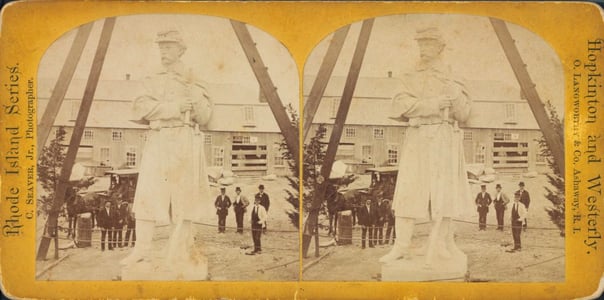Growing up in Westerly, Rhode Island, a town in which more than 30% of residents identify as having Italian ancestry, I was always surrounded by Italian culture.[1] To this day, many people from other towns are surprised to hear that my high school offered Italian language courses, a fairly uncommon option. Even fewer had heard of Soupy, the nickname for soppressata, the cured meat which originated in Calabria that hangs in the basements and attics of Westerly residents during certain times of the year. (The meat curing process requires outdoor temperatures of 45 to 55 degrees Fahrenheit.)[2]
My heritage has always been a point of pride in my family. My great-grandmother was a proud member of local clubs including the Italo-American Auxiliary Club and the Daughters of Italy. While I always knew of my Italian roots, only recently have I discovered more about the community where my family originated.
Westerly has long been a town which prides itself on its heritage, with many of its prominent citizens descending from immigrant ancestors who settled in the nineteenth and twentieth centuries. One of the major reasons that Westerly became a destination for immigrant workers was its rich deposits of granite, which were quarried by various companies, an enterprise requiring thousands of workers.
Granite extracted from Westerly's quarries was used for monuments across the country, including 69 monuments at Gettysburg and 14 monuments at Antietam.[3] One company, the Smith Granite Company, is responsible for 3,754 monuments in 32 states across America.[4] While other immigrant groups contributed to Westerly's granite industry, including the Irish in the 1850s, the Scottish in the 1870s, and the Finns in the 1890s, no group has had a more significant impact on the community than the Italian immigrants.[5]
The town of Acri, Calabria, was the point of origin...
The town of Acri, Calabria, was the point of origin for many Westerly immigrants who arrived during the late nineteenth and early twentieth centuries.[6] While many immigrants came from other locations throughout Italy, Acri is the most prevalent town of origin. A town of just over 21,000 residents in the heart of Calabria,[7] Acri is surrounded by three hills (which appear on the town's coat of arms), and it is renowned for its picturesque landscape and beautiful churches.
The connections between Acri and Westerly run deep, as the Church of the Immaculate Conception, the parish attended by many Italian immigrants and their descendants in Westerly, maintains an exact replica of the likeness of Beato Angelo d’Acri, a famed saint from the Italian town.[8] The church also holds annual trips to Acri, allowing many residents to return to see family and friends from their former homeland.
While conducting research regarding my own ancestors who came from Acri, I found that many of my ancestors shared surnames with Westerly residents with whom I grew up and have come to know throughout my life. I learned rather quickly that heritage in Acri was shared among many of my friends. Amazingly, a town nearly 4,500 miles from where I was born was not only the home of my ancestors, but also of the ancestors of so many other friends and family members, showing me how widespread the migration from one town in Italy to another across the Atlantic Ocean truly was. While I have not yet been able to visit Acri, I hope to be able to do so in the very near future, as I have a strong desire to venture to the home of my ancestors and to see the world as they saw it.
Notes
1 United States Census Bureau, 2010-2014 American Community Survey 5-Year Estimates, Westerly, Washington, Rhode Island.
2 Doug Norris, “In Westerly’s Villages, Family Tradition Keeps the Art of Soupy Alive,” The Independent, 29 December 2011.
3 Westerly Granite at Antietam, Babcock Smith House pamphlet (2011); Westerly Granite at Gettysburg, Babcock Smith House pamphlet (2011).
4 The Granite Connection, Babcock Smith House pamphlet (2011).
5 Ibid.
6 Rob Liguori, “Soupy’s On,” Rhode Island Monthly, December 2007.
7 Population.City, Acri, Calabria, Italy, 2014.
8 Biography of Beato Angelo, Church of the Immaculate Conception, Westerly, Rhode Island, http://immcon.org/beato-angelo.
Share this:
About Zachary Garceau
Zachary J. Garceau is a former researcher at the New England Historic Genealogical Society. He joined the research staff after receiving a Master's degree in Historical Studies with a concentration in Public History from the University of Maryland-Baltimore County and a B.A. in history from the University of Rhode Island. He was a member of the Research Services team from 2014 to 2018, and now works as a technical writer. Zachary also works as a freelance writer, specializing in Rhode Island history, sports history, and French Canadian genealogy.View all posts by Zachary Garceau →
